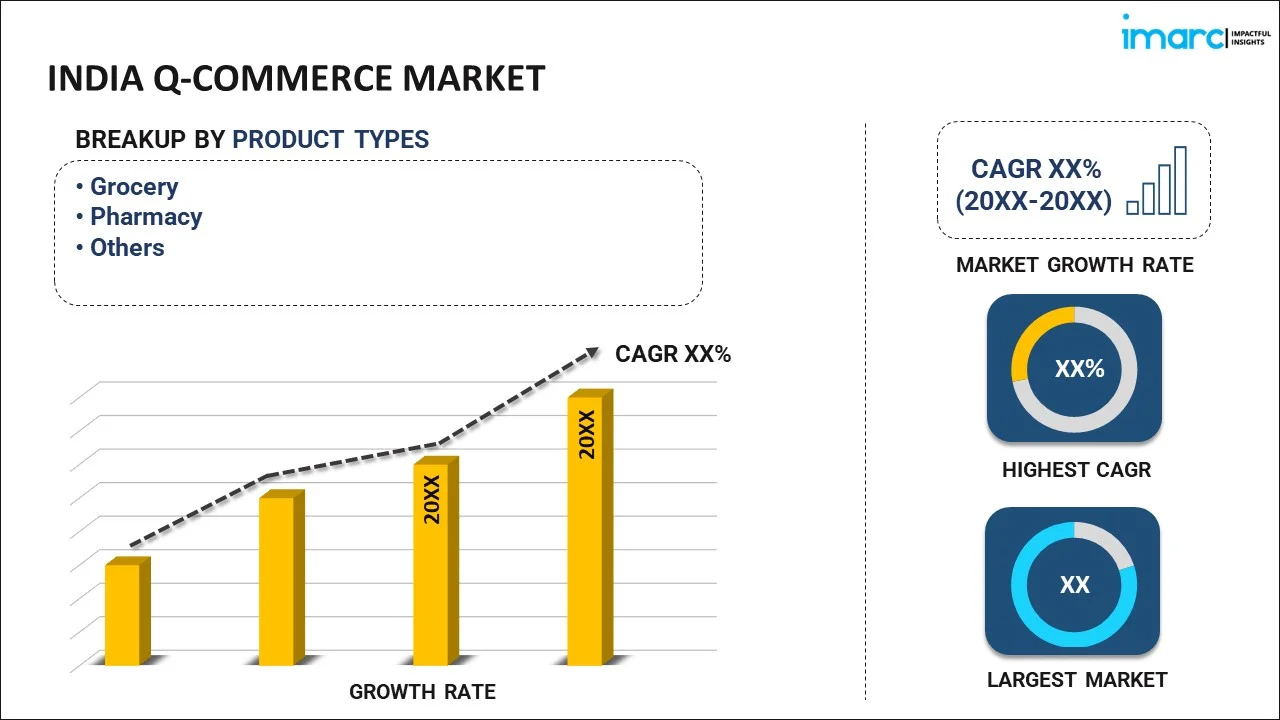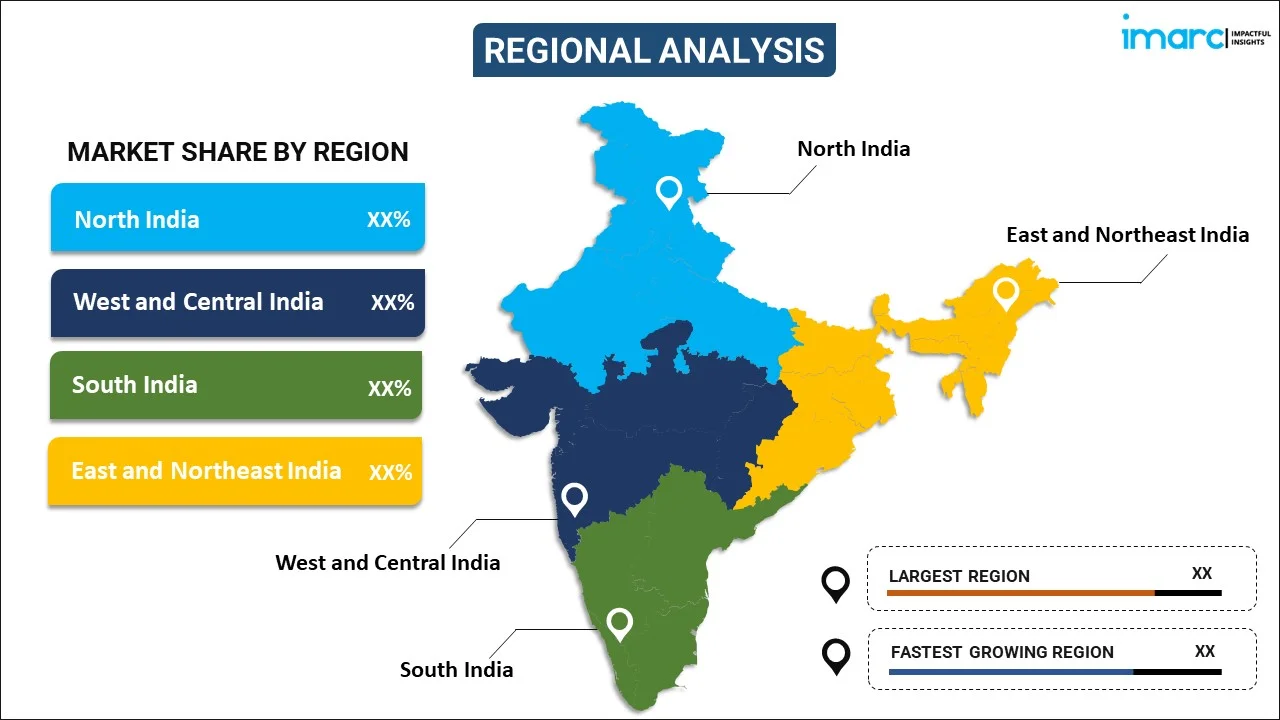
India Q-Commerce Market Report by Product Type (Grocery, Pharmacy, and Others), Platform (App Based, Web Based), and Region 2025-2033
Market Overview:
India q-commerce market size is projected to exhibit a growth rate (CAGR) of 45.6% during 2025-2033. The inflating need among consumers for safe and contactless shopping options and continuous investments in logistics infrastructures are primarily driving the market growth.
|
Report Attribute
|
Key Statistics
|
|---|---|
|
Base Year
|
2024 |
|
Forecast Years
|
2025-2033 |
|
Historical Years
|
2019-2024
|
| Market Growth Rate (2025-2033) | 45.6% |
Q-commerce is an emerging phenomenon in the retail and delivery sector, denoting the swift delivery of consumer goods and groceries, often accomplished within minutes via online platforms or mobile applications. This inventive strategy leverages nearby micro-fulfillment centers and a team of couriers to guarantee swift order processing. The transformation brought about by quick commerce is redefining the conventional retail scene, providing unprecedented convenience to consumers desiring instant availability of everyday necessities. The surge of q- commerce is propelled by changing consumer inclinations favoring on-demand shopping, marking it a pivotal advancement in the realms of e-commerce and last-mile delivery services.
India Q-Commerce Market Trends:
The India q-commerce market is currently undergoing a transformative phase, driven by several key drivers and trends that are reshaping the landscape of retail and delivery services. Firstly, the rapid digitalization and increasing smartphone penetration in India have played a crucial role. As more consumers embrace online platforms and mobile apps for their shopping needs, the demand for quick commerce solutions has surged, leading to an evolution in how goods are delivered with unprecedented speed. Additionally, the rise of hyperlocal micro-fulfillment centers has become a pivotal driver in the q-commerce ecosystem. These localized fulfillment hubs strategically placed in urban areas enable faster order processing and delivery within minutes. This localization trend is instrumental in meeting the growing consumer expectations for swift and on-demand access to a wide range of products. Furthermore, changing consumer lifestyles and preferences are contributing to the momentum of q-commerce in India. Apart from this, the integration of advanced technologies, such as artificial intelligence and data analytics, is also shaping the q-commerce landscape. These technologies enhance operational efficiency, optimize route planning for deliveries, and provide a personalized shopping experience for consumers. Moreover, changing consumer lifestyles and technological advancements are making it a dynamic and rapidly evolving sector within the broader e-commerce industry, which is anticipated to fuel the market growth over the forecasted period.
India Q-Commerce Market Segmentation:
IMARC Group provides an analysis of the key trends in each segment of the market, along with forecasts at the country level for 2025-2033. Our report has categorized the market based on product type and platform.
Product Type Insights:

- Grocery
- Pharmacy
- Others
The report has provided a detailed breakup and analysis of the market based on the product type. This includes grocery, pharmacy, and others.
Platform Insights:
- App Based
- Web Based
A detailed breakup and analysis of the market based on the platform have also been provided in the report. This includes app based and web based.
Regional Insights:

- North India
- West and Central India
- South India
- East and Northeast India
The report has also provided a comprehensive analysis of all the major regional markets, which include North India, West and Central India, South India, and East and Northeast India.
Competitive Landscape:
The market research report has also provided a comprehensive analysis of the competitive landscape in the market. Competitive analysis such as market structure, key player positioning, top winning strategies, competitive dashboard, and company evaluation quadrant has been covered in the report. Also, detailed profiles of all major companies have been provided.
India Q-Commerce Market Report Coverage:
| Report Features | Details |
|---|---|
| Base Year of the Analysis | 2024 |
| Historical Period | 2019-2024 |
| Forecast Period | 2025-2033 |
| Units | Million USD |
| Scope of the Report | Exploration of Historical Trends and Market Outlook, Industry Catalysts and Challenges, Segment-Wise Historical and Future Market Assessment:
|
| Product Types Covered | Grocery, Pharmacy, Others |
| Platforms Covered | App Based, Web Based |
| Regions Covered | North India, West and Central India, South India, East and Northeast India |
| Customization Scope | 10% Free Customization |
| Post-Sale Analyst Support | 10-12 Weeks |
| Delivery Format | PDF and Excel through Email (We can also provide the editable version of the report in PPT/Word format on special request) |
Key Questions Answered in This Report:
- How has the India Q-commerce market performed so far and how will it perform in the coming years?
- What has been the impact of COVID-19 on the India Q-commerce market?
- What is the breakup of the India Q-commerce market on the basis of product type?
- What is the breakup of the India Q-commerce market on the basis of platform?
- What are the various stages in the value chain of the India Q-commerce market?
- What are the key driving factors and challenges in the India Q-commerce?
- What is the structure of the India Q-commerce market and who are the key players?
- What is the degree of competition in the India Q-commerce market?
Key Benefits for Stakeholders:
- IMARC’s industry report offers a comprehensive quantitative analysis of various market segments, historical and current market trends, market forecasts, and dynamics of the India Q-commerce market from 2019-2033.
- The research report provides the latest information on the market drivers, challenges, and opportunities in the India Q-commerce market.
- Porter's five forces analysis assist stakeholders in assessing the impact of new entrants, competitive rivalry, supplier power, buyer power, and the threat of substitution. It helps stakeholders to analyze the level of competition within the India Q-commerce industry and its attractiveness.
- Competitive landscape allows stakeholders to understand their competitive environment and provides an insight into the current positions of key players in the market.
Need more help?
- Speak to our experienced analysts for insights on the current market scenarios.
- Include additional segments and countries to customize the report as per your requirement.
- Gain an unparalleled competitive advantage in your domain by understanding how to utilize the report and positively impacting your operations and revenue.
- For further assistance, please connect with our analysts.
 Inquire Before Buying
Inquire Before Buying
 Speak to an Analyst
Speak to an Analyst
 Request Brochure
Request Brochure
 Request Customization
Request Customization




.webp)




.webp)












